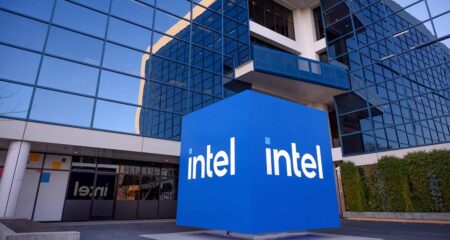
Intel has announced several advances in chip technology that show it is keeping up with the demanding pace of Moore’s Law, which predicts a doubling of semiconductor performance every two years.
Formulated in 1965 by Intel chairman emeritus Gordon Moore, Moore’s Law isn’t guaranteed. But the chip maker’s announcements show that the world’s biggest chip maker is still delivering on Moore’s prediction. The new advances include leaps in energy efficient computing, low-voltage processing, integrated digital radios and efficient processor graphics. Intel made the announcement through various talks at the International Solid State Circuits Conference, an engineering and science event that starts today in San Francisco.
“Energy efficiency has been Intel’s goal for many years now,” said Justin Rattner, chief technology officer at Intel, in a call with reporters. “We do it to minimise the energy impact on the environment but also to make Intel’s products more scalable across the computing continuum.”
That means Intel is creating energy efficient chips for low-power mobile devices all the way up to high-performance super computing chips. In contrast to past years where performance alone mattered, Intel’s chips are now designed to work within limited energy budgets. Various techniques now allow a five- to 10-times improvement in energy efficiency, or higher performance per watt of power consumption.
Intel’s latest advances include the ability to operate at “near-threshhold voltage”, which balances fast operation and low-power use. Chips today have to be able to operate at a greater dynamic range, starting at a few megahertz and skyrocketing to a gigahertz or more for an urgent task, then returning to the megahertz level again. Intel’s experimental 32-nanometre chip, based on the original Pentium processor chip design from 1993, can operate at 3MHz at 280 millivolts and then shoot up to 915MHz at 1,2V.
Intel has also managed to reduce the amount of voltage required to run a memory chip as well as a processor-graphics combination chip.
In digital radios, Intel has integrated a Wi-Fi radio into a system-on-a-chip package that includes two Atom processor cores. The 32-nanometre chip could drive down the cost and size of future mobile devices.
“That’s enabling Moore’s Law for RF (radio frequency) circuits,” which typically don’t scale well as you shrink the circuits from one generation to the next, Rattner said. “We are getting close to having the complete kit of digital radio building blocks.”
Normally, radio circuits create interference with other circuits, but Intel has successfully integrated the radio portion of a chip just millimetres away from other processor elements. The barriers to doing a commercial version of this kind of chip are falling rapidly, Rattner said.
“We’ve moved to rethink radio from a computational perspective,” Rattner said.
Over time, Rattner said Intel also hopes to build a cellular phone radio that can be embedded in an Intel processor chip.
Intel has also improved maths with so-called floating point processing without compromising energy efficiency. This 32-nanometre experimental chip varies the precision of its floating point calculations in a dynamic manner. The chip uses 50% less power and is seven times more energy efficient than regular chips.
On a near-term basis, Intel is also talking about Ivy Bridge, the code name for a new processor that will be the first to use Intel’s new 3D Tri-Gate 22-nanometre transistor technology. — Dean Takahashi, VentureBeat![]()
- Subscribe to our free daily newsletter
- Follow us on Twitter or on Google+ or on Facebook
- Visit our sister website, SportsCentral (still in beta)




